| Columns Retired Columns & Blogs |
Transcendent T8 OTL monoblock power amplifier Measurements
Sidebar 5: Measurements
Because of the high-power limitations of the Transcendent OTL monoblock's tubes, its manufacturer recommended against a high-power pretest. Instead, I warmed up the amplifier at 1W for one hour, following which I tweaked the bias in accordance with the directions in the owner's manual. The amplifier runs quite warm, but not unexpectedly so for a tube amplifier.
The Transcendent's input impedance measured 115k ohms, its voltage gain a very low 20dB. I strongly recommend that if your loudspeakers are of average sensitivity, you pair this amplifier with a preamp having at least 12dB of gain. (I do not recommend a "passive" preamp with the Transcendent.)
The amplifier was noninverting. Its S/N Ratio measured 69.5dB from 22Hz to 22kHz, 69.4dB from 10Hz to 500kHz, and 82dB A-weighted. The output impedance was at or below 0.37 ohms at 1kHz and 20Hz, increasing to 0.47 ohms into a 4 ohm load at 20kHz. This is a lower output impedance than that of most tube amplifiers with transformers. DC offset at the outputs fluctuated considerably, and while it remained under 10mV much of the time, there were occasional instantaneous peaks to above 60mV—still not high enough to be of concern.
Fig.1 shows the Transcendent OTL's frequency response. Note that the high-frequency response falls off more rapidly into 4 ohms than into 8, though the difference in the audible range is of little significance. The response deviation into our simulated real load is small, though it may be barely audible.

Fig.1 Transcendent T8, frequency response at (from top to bottom at 10kHz): 1W into 8 ohms, 2W into 4 ohms, and 2.83V into simulated speaker load (0.5dB/vertical div.).
The 10kHz squarewave response in fig.2 has a good risetime, though there's a single half-cycle of damped overshoot visible. This is also present as a just-apparent spike in the 1kHz squarewave (not shown). The distortion curves in fig.3 show reasonably good linearity across much of the frequency band, though the amplifier is clearly starting to become uncomfortable into 2 ohms. The distortion waveform in fig.4 shows significant amounts of both second and third harmonic. Into 8 ohms, the second harmonic is clearly primary, and into 2 ohms, the third (neither shown)—more indications that you should avoid very-low-impedance loads with the Transcendent.
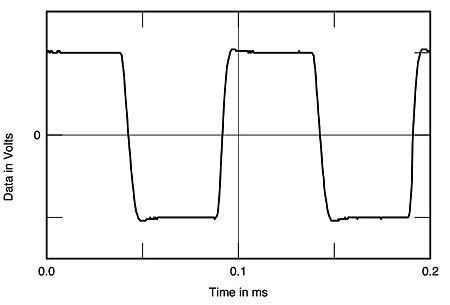
Fig.2 Transcendent T8, small-signal 10kHz squarewave into 8 ohms.
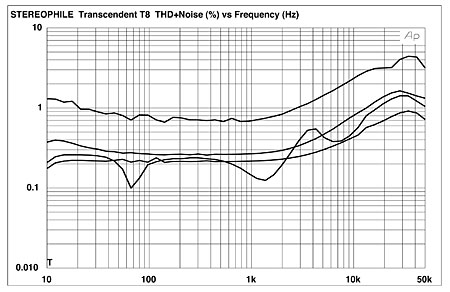
Fig.3 Transcendent T8, THD+noise vs frequency at (from top to bottom at 5kHz): 4W into 2 ohms, 2W into 4 ohms, 2.83V into simulated speaker load, 1W into 8 ohms.
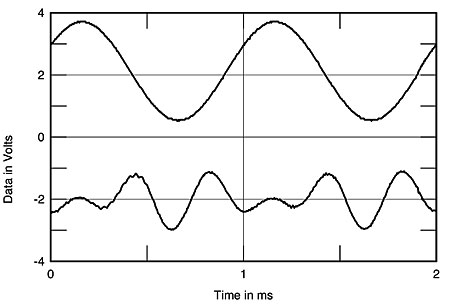
Fig.4 Transcendent T8, 1kHz waveform at 2W into 4 ohms (top); distortion and noise waveform with fundamental notched out (bottom, not to scale).
The 1kHz, THD+noise vs output power sweeps in fig.5 also show the amplifier's preference for loads of higher impedance. Indeed, if we were to use 1% as a clipping reference, the Transcendent barely puts out just under 4W with a 2ohm load at 1kHz. As we often do with tube amplifiers, however, I've chosen here to define the 1kHz discrete clipping levels as 3% THD+Noise. The latter are at 41.3W (16.2dBW) at 8 ohms, 32.5W (12.1dBW) at 4 ohms, and 17.8W (6.5dBW) at 2 ohms. The voltage of the power line was 115–117V during these measurements.
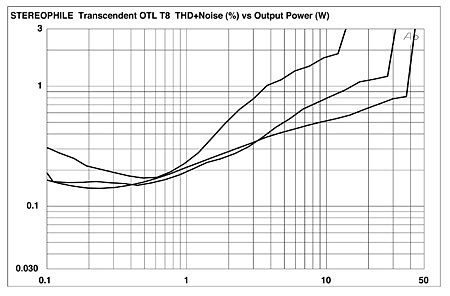
Fig.5 Transcendent T8, distortion (%) vs output power into (from bottom to top at 10W): 8 ohms, 4 ohms, and 2 ohms.
I rechecked these figures the next day and obtained slightly higher readings: 44W into 8 ohms (116V), 38.8W into 4 ohms (116V), and 21.5W into 2 ohms (115V). The only explanation I can offer for the difference is the fact that the amplifier was operating for just over an hour (mostly idle warmup) prior to the clipping measurements on day 2, and for about 3 hours (idle warmup plus taking most of the above measurements) before the clipping test on day 1.
A plot showing the output spectrum resulting from a 50Hz input (20.4W into 4 ohms) is shown in fig.6. The second harmonic here is at –48dB (0.4%), the third at –42dB (0.8%). At 18.6V into our simulated real load, the corresponding results (not shown) were –45dB (about 0.6%) and –51dB (about 0.3%), respectively. Fig.7 shows the IM spectrum for a 19+20kHz input at 6.1W output into an 8 ohm load. This is the maximum output possible with this input signal into this load prior to visible clipping (observed on a 'scope). Transcendent says that, for sonic reasons, they deliberately limit the output power of the amplifier at higher frequencies. The IM here is –31dB (about 3%) at 18kHz, – 42dB (0.8%) at 17kHz, and –26dB (about 4.5%) at 1kHz. At 4.2W into 4 ohms (again, just prior to clipping), not shown, the 19+20kHz IM spectrum looks similar, and the corresponding distortion is just slightly higher (1–2dB).
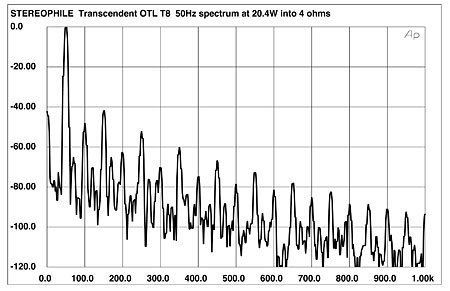
Fig.6 Transcendent T8, spectrum of 50Hz sinewave, DC–1kHz, at 20.4W into 4 ohms (linear frequency scale).
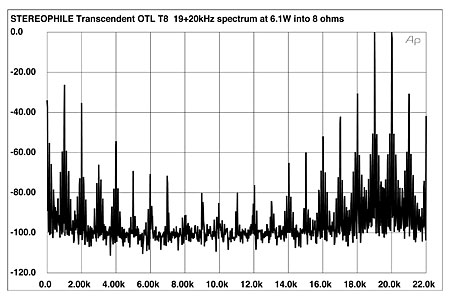
Fig.7 Transcendent T8, HF intermodulation spectrum, DC–22kHz, 19+20kHz at 6.1W into 8 ohms (linear frequency scale).
The test-bench results here are mixed, the T8's relatively mediocre IM distortion counterbalanced by its low (for a tube amplifier) output impedance and good, low-power THD+noise.—Thomas J. Norton
- Log in or register to post comments



































